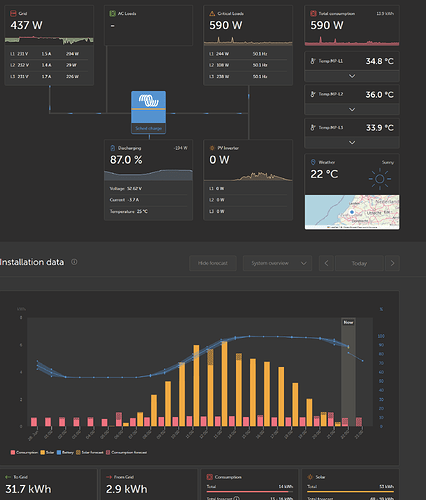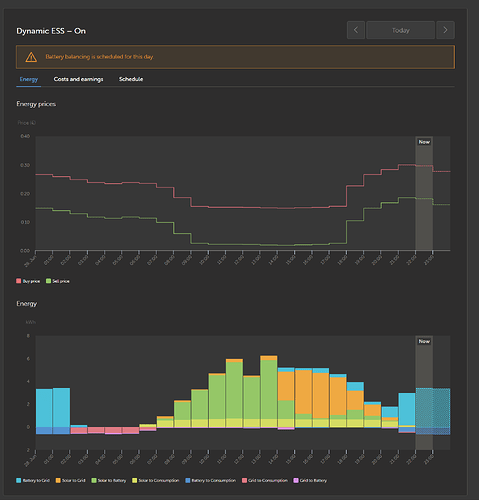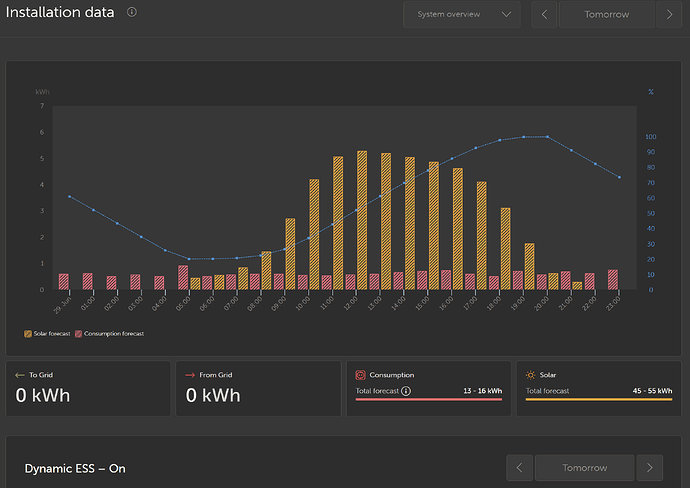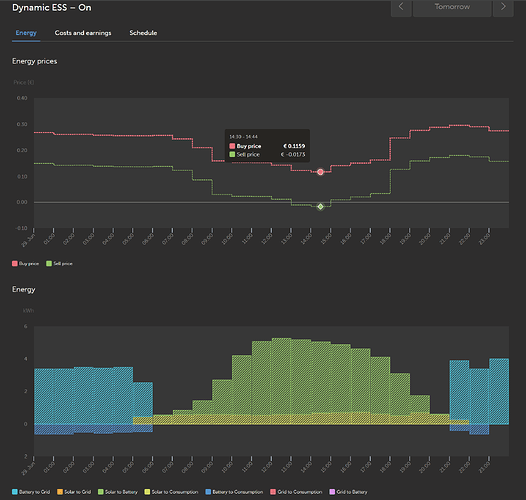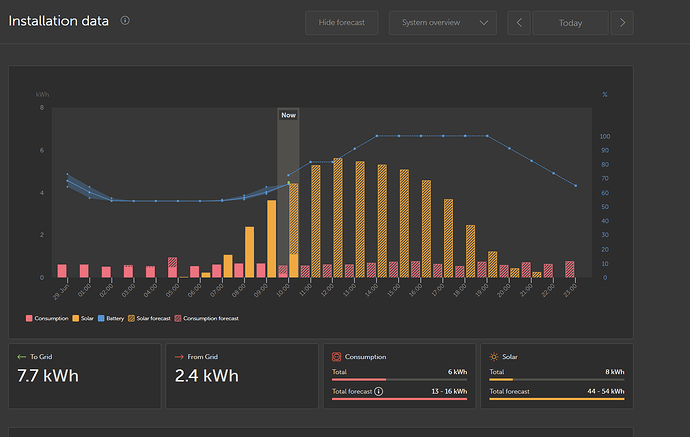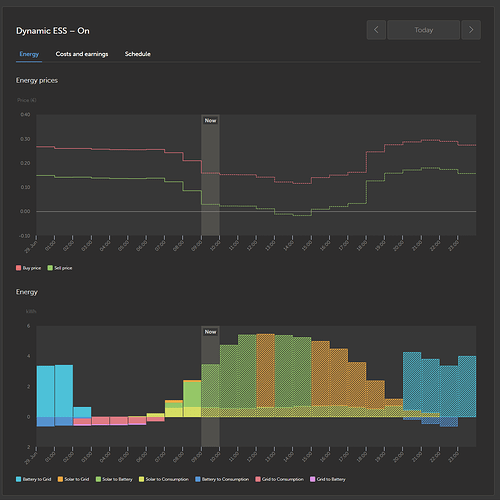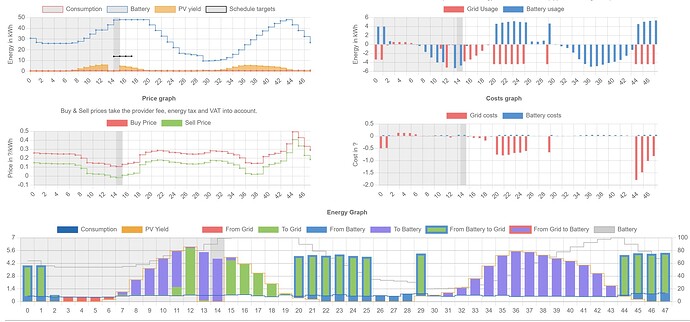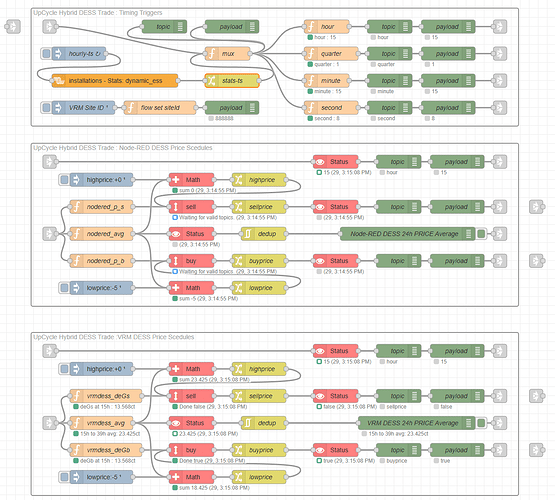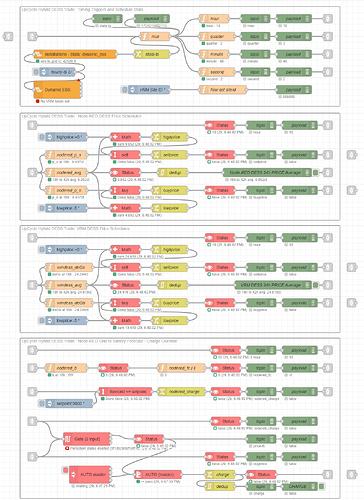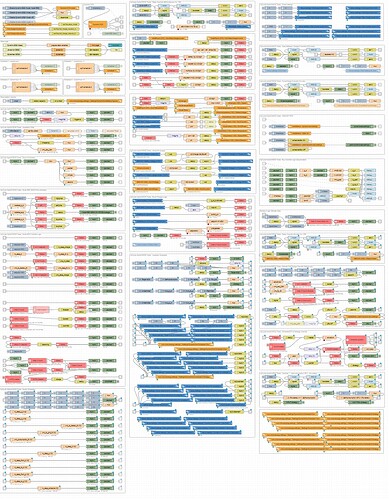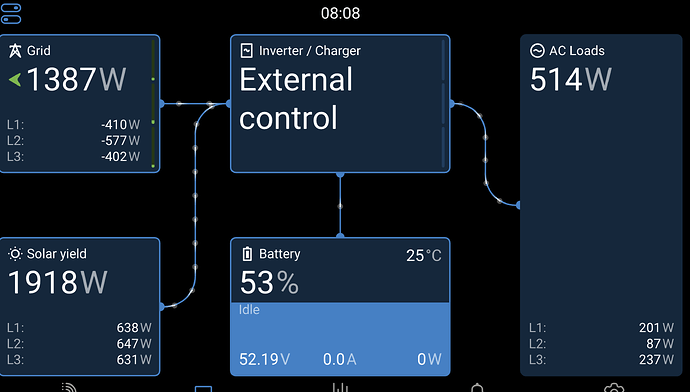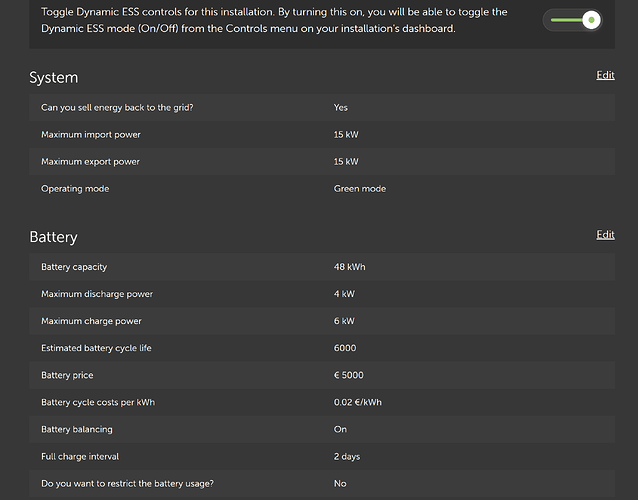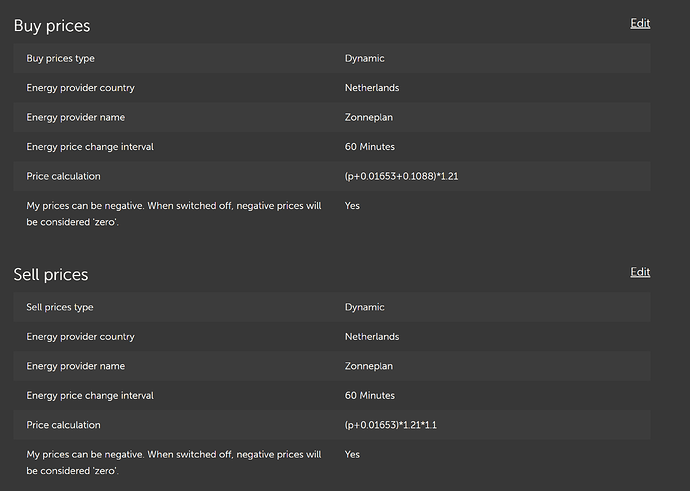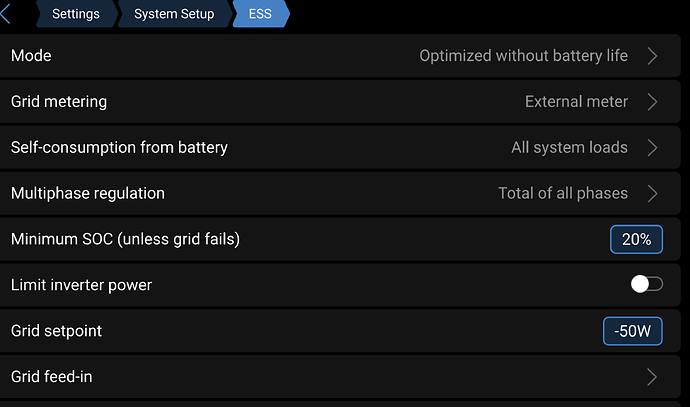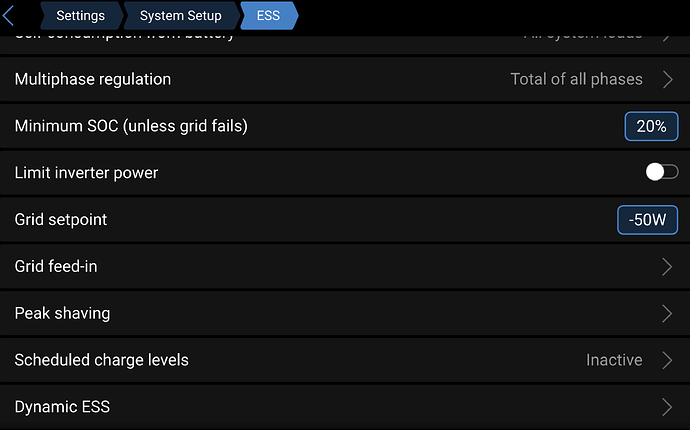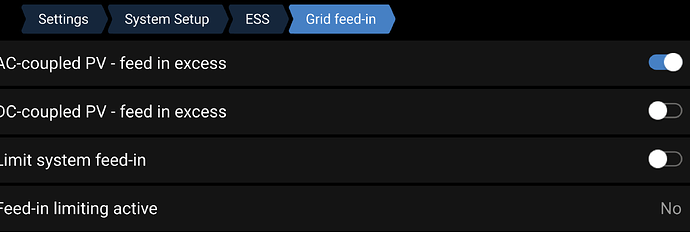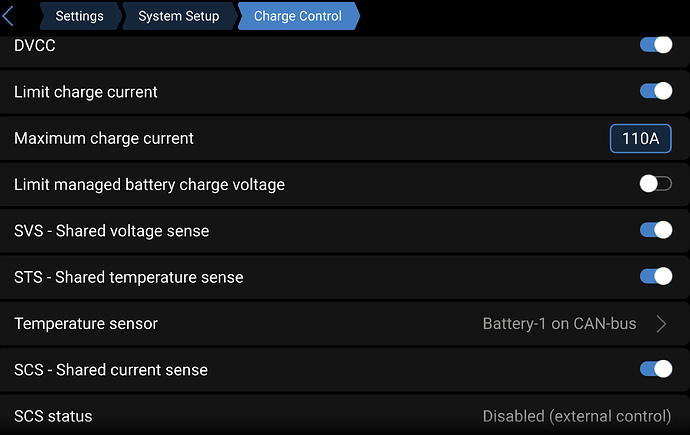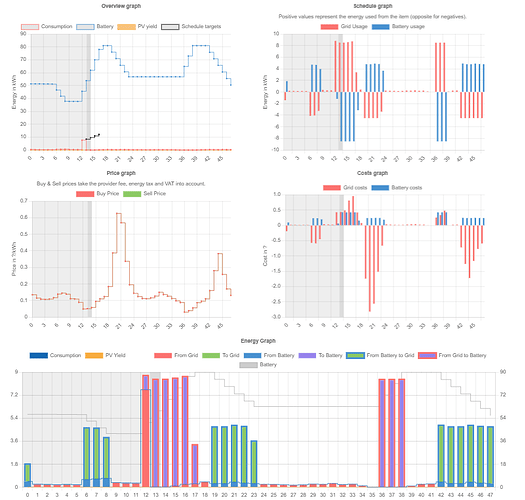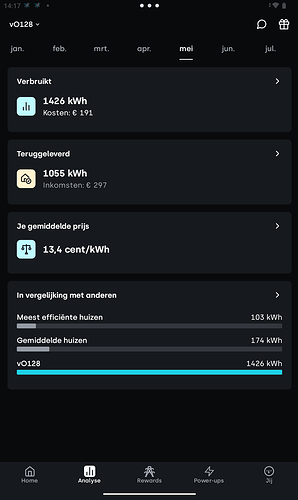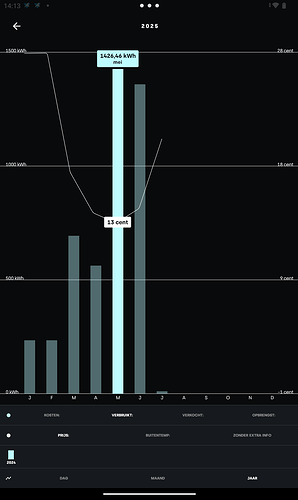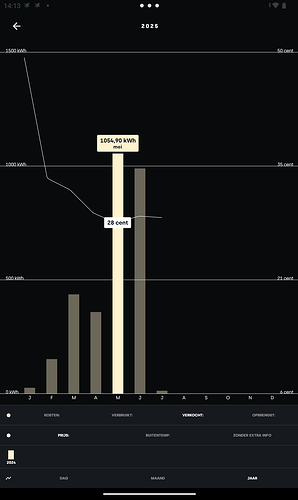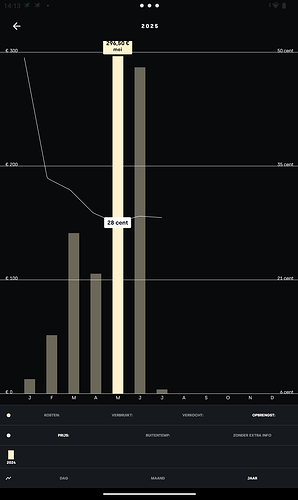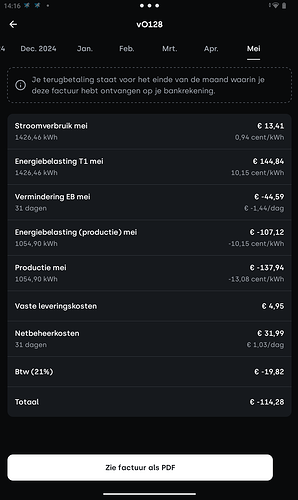Not that could find, but the DESS (Trade?) scheduler is primarily targeting minimum SoC at the end of it’s known price forecast window so my working assumption is that discharging comes implicitly. And is somewhat self adjusting when combined with the ‘Optimized with Batterylife’ ESS setting enabled.
Ttis is the situation of this evening. Suddenly The system drains energy from grid while the DESS forcast shows it should only do battery to grid and consumption. I looked at the system for a while and all the time it drew 400 to 1000W from grid. Why?
The battery SOC graph shows it is still aboe the forcasted SOC, so there is no reason to get energy from grid. And even if DESS for some reason thinks there is to much energy flowing out of the battery then why not lower the discharge rate instead of taking from grid?
This night the same thing happened. At least DESS is consistant.
This time I captured the predictions beforehand to show how the actual results differ.
Screenshots from the DESS forecast taken round midnight:
And the actual data from this moment:
For one thing, why is the forecast to discharge the battery to 20% but in reality it only goes to around 60%? Prices did not change, parameters are still the same. So what can happen or why is DESS disagreeing with itself?
(oh and this is in green mode)
What cost have you configured for the battery interval??? Or have you configured anything about the efficiency in Nodered???
My settings are shown inthe first post (except that I now run in green mode).
The battery cycle costs are 2 ct/kWh.
I have the flow from @UpCycleElectric running that sets pfcso between 11:00 and 17:00 to 100%
And the example flow fetch-dynamic-ess (from victron-dynamic-ess) to get the different dashboard:
Here is a cleaned up flow for using price schedule triggers (for instance to switch on/off the periodic full charge override)
Top group creates an hourly timestamp ‘on the hour’
Middle group uses Node-RED DESS price schedules. (if installed, DESS mode can stay on 1: auto / VRM)
Bottom group uses VRM DESS price schedules.
You need to have VRM-API up and running or Node-RED DESS (or both) . The Node-RED DESS group needs to be in the same flow as the Node-RED DESS Dynamic ESS node because that node stores its ‘stats’ in the flow context. See also the price functions for the differences in accessing VRM-API versus Node-RED DESS scheduling stats. and how the average is calculated, adjust to your needs where required.
The price averaging takes todays price average upto the moment new prices roll in, then it calculates a rolling 24 hour window average, until midnight.
UpCycle Hybrid DESS Trade Price Trigger Flow_v0.3.zip (6.3 KB)
PS, I use this on tibber dynamic pricing with equal sell and buy prices and a battery cost of 10ct.
When the hourly/current price is 5ct below average it sends a ‘buy’ signal that switches on a full power charge run (and off when price gets higher again).
And when price is above average it sends a ‘sell’ signal, that I use to override the schedule strategy to lock it into ‘1 : self consumption’.
The next part I am cleaning up is the logic that uses the target SoC and target charge (kWh) schedules.
With the ability to have VRM DESS on different settings (Green vs Trade and others ) than Node-RED DESS (Trade plus a high% b_goal_SoC around dinnertime) , both schedulers can provide (significantly) different schedules. This then allows for some very interesting tailermade ‘logic’ to set several ‘timed and conditional options’ on DESS to make it do what you want when you want it to.
Why do have such large differences set in sell and but price? I think that can really skew DESS of track (unless that is really what your energy provider charges and pays) . I have seen some people set an offset on purpose but that can much better be done by increasing the battery cost itself. Also, what are your b_goal_SOC and b_goal_hour settings?
I can’t really put my finger on it but I think you need to revisit your basic power and capacity setting to make sure those are as accurate for your actual setup as possible. Try to use as little other options as possible to try manipulate DESS as well.
That said you seem to get closer, next step would be to ditch the timer based PFCO for a hybrid approach using the Node-RED ‘grid-to-battery’ schedules that, if set correctly, will be biased significantly towards a full battery in the late afternoon / early evening,
UpCycle Hybrid DESS Trade Price and Forecast Charge Trigger Flow_v0.1.zip (9 KB)
Have fun.
Getting closer, still a bit to go:
I think i stil have to learn al lot about the simpler things of ESS/DESS ![]()
past night agina the smae behaviour, after swithcing of all node-red flows.
So I just tried to force to discharge the batterie by switching off DESS, and set the grid setpoint to -3kW. Battery is at 53% but ESS does not start discharging. Solar now produces 1600W, consumption is around 500W but only 1100W going out to the grid. I would expect that when I set the grid setpoint, ESS would try to adhere to that.
I’m not up to speed with node-red yet… But I’m now looking for a simple flow that allows me to just force the amount of energy that goes in or out the grid, i.e. forcing to discharge the batteries (up to the set minimum SOC). Can you help me with that Jan (or anyone else)?
The grid setpoint has a limited ‘bandwith’ of a few hundred watt, and is meant only to create a small bias to either consume or feed-in. There is a thread about that somewhere. To force a substantial discharge you should only need to have an actual SoC above minimum SoC and set ESS to target SoC.
I am not sure what is the best way to force the inverter into maximum energy output, I never ran into that situation because DESS Trade will always try to sell down to minimum SoC if the price is high enough.
I do agree though that it would be quite handy, especially when still getting to know the system, to have a very simple flow to steer the inverter directly, the function you expected the ‘grid setpoint’ to have but simple doesn’t.
Let’s review and simplify your settings and take it from there
What simplification would you suggest?
I just remove the charge/discharge restirction but furthermore everything is pretty standard.
(PS: I tried to change the battery price setting, but somehow I’m now only allowed to enter a single digit number, so in the end just left it as is)
If you give an overview of your system and current settings I can check
These are my DESS settings at the moment:
I have three MP2-5000 and 3 times16kWh batteries, and 8kW solaredge array on AC-out side (3-phase)
Cerbo settings:
Hope this is enough.
Bottme line still is: why does DESS refuese to discharge my batteries below 50 to 60% while the minimum SOC is set to 20% !!!
3xmp2 5000 Why 4 kW discharge rate? Why 6 kW charge rate? Both values seem unrealistic to me. Battery equalization every 2 days? In my opinion, you should review the entire configuration.
I limited discharge (and charge) rate to make sure the battery is not discharged to quiclly causing the system to take energy from grid to feed consumtion. With the 4k limit only the last few hours before sunrise will use energy from grid.
The charging and discharging parameters in the DESS are not limiting. They have no controlling effect. They simply serve as a calculation basis for the DESS. You control your charging and discharging parameters in the DVCC or via the BMS. Once you have realistic values for your system, you enter them into the DESS as a calculation basis. Based on these values, your DESS then plans the time phases during which it will charge or discharge. This is also stated in the manuals. The way you’ve configured it, it can’t work at all. Sometimes you should read the manuals. Sorry for the blunt language.
Will look into it later, a little hot today to sit inside ![]()
Hope you are ‘backing up the the truck’ today, with evening prices skyrocketing:
@Sarowe1990, no wories about the blunt ‘hints’. I completely agreee with you. As rookie there is a lot of manuals info to swallow and then to read the docs in the right order might be another thing ![]() In the mean time one like to test things. Using the limit discharge value seemwd to help though to spread the discharge during the night…
In the mean time one like to test things. Using the limit discharge value seemwd to help though to spread the discharge during the night…
I may have found a very different cause for the fact the batteries will not go lower than around 50%. I looks like the JKBMS is somehow disallowing it to go furthere down. Not sure why but when I switched off DESS and forced a gridsetpoint of -5000 the batteries still did not start to discharge further…
If you want, I propose we do an experiment setting up your system in DESS Trade mode first and get that behaving properly. That way most of the Green mode complexity won’t get in the way of understanding what is going on. Then we add the PFCO to that to get your batteries working for your you, and only thereafter we reenable Green mode to see what the difference is about and see whether all extra (Green mode) complexity is adding any practical value in practice, or not.
When does your dynamic pricing contract start?
PS, can you give some estimates of your dayly/monthly power stats: grid import and export, solar production, self consumption. I assume that may be quite different then our system where our self consumption is dwarfed by the trading volume and solar is absent completely. To give you an idea of what we did on a single phase 35A ‘smeltzekering’ with a single MP II 5000 and a separate boost charger to up the maximum charge power right up to the fuses limits (a little over actually, 39Amp (230Vac) continuous on full power.:
That was may, juni is just like it. Roughly 1350kWh bought, 1000kWh sold, the difference 350kWh is more heat losses than self consumption I think. Still over €100 payout on say 1000kWh cycled gives a nice 10ct/kWh to compensate battery cost and leave some on the table still, not to mention no cost for heating and self consumption.
The real opportunity lies in adding just enough solar to this system to recoup all the taxes payed, that would be the optimum profitability case.
And arguably: still very green because our system buys the surplus solar production from the neighbours so to say.
Biggest difference to your system is our battery capacity of 70kWh useable dayly, but as seen from the data only 35 - 45kWh is cycled dayly, with good tuning you should be able to get reasonably close to that, upto double if adding more capacity in the future. And capacity cost will keep going down I believe so that might be quite interesting for the future for you.
